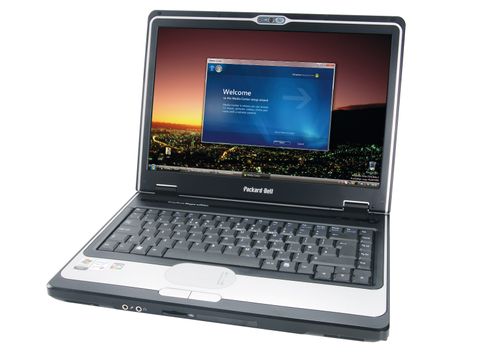TechRadar Verdict
Ultimately, this is a slightly above average laptop with one single gimmicky feature to try make it stand out
Pros
- +
Excellent display
Decent core spec
Cons
- -
Skype button poorly placed
Wi-Fi indicator poorly conceived
Poor touchpad
Why you can trust TechRadar
Could this seemingly unexciting machine offer a glimpse at the future of laptop computing? Or is this just another piece of cynical marketing intended to separate less experienced users from their hard-earned cash?
Having thoroughly tested the machine, we'd have to lean to the side of the latter, although as ever there are exceptions to that rule.
As you can guess from the name, Packard Bell has teamed up with Skype to produce a laptop that provides an 'easier way to keep in touch with family and friends'.
In more technical terms, this means there's a button next to the built-in camera that launches Skype. Hardly the stuff of Tomorrow's World, now is it?
Ergonomically we're not convinced this is even the best place for the button, as pushing it causes the machine to rock backwards. At least it works, though, and it does provide easy access for answering incoming calls as well as initiating them.
Of course older notebooks could do this with a user programmable launch key, but this machine is clearly aimed at a market that would never set up such a system. And we can see that the less computer savvy would be able to use this without much fuss.
Touchpad nightmare
One design choice that completely baffled us, however, was the indicator for the machine's integrated Wi-Fi, probably an intrinsic part of any Skype call. This button will glow when the machine is actually connected to a network, but since connections take time to actually be made, there's no immediate way of telling whether you've just turned it on or off again.
Thankfully the Wi-Fi can be turned on and off in the more traditional Fn | F2 combination, reducing the button to a simple indicator, but this almost defeats the object of aiming this machine at a more novice audience.
We have one more gripe about the machine before we touch on the positives - and it's about the keyboard and mouse. Laptop touchpads are rarely pleasurable to use, but Packard Bell really is testing its luck here, with one of the smallest areas we've ever witnessed.
That it measures 1.5in high and two wide is bad enough, but the styling means that this has been reduced to a frustratingly small square area, out of synch with the actual display. The keyboard shows bubbling too, raised in the middle, so it's rather unpleasant to use.
One of the highpoints of the EasyNote is the screen. Using a finish that Packard Bell terms 'DiamondView', the XBlack like reflective finish is a nice touch in a machine of this stature, and even though it only measures 14in across, it renders movies well and produces vivid colours when the lighting isn't too bright.
The default resolution of 1280 x 800 works well with the space on offer too. As a media machine the sound is a little weedy, and is often drowned out by the excessively loud fans, but at least you can use the headphone jack for better clarity.
This isn't a gaming machine though. A 3DMark05 score of 528 indicates that this machine is missing the power demanded by existing games, let alone those of tomorrow. As this machine uses Intel's older integrated graphics, this is no great surprise.
In real terms, you're looking at only two or three frames per second - hardly what could be considered smooth. If you need further proof of the lack of might on offer with this laptop, then the 3DMark06 result of 134 should be all that's needed to send would-be gamers running in the opposite direction.
Battery life
While the graphics prowess isn't stunning, the rest of the core components are respectable enough. At the heart of the machine you'll find the Intel Core 2 Duo T5200, which trundles along at a decent 1.6GHz and has enough grunt to handle anything remotely serious.
This is backed up by 1GB of RAM, which makes for a solid backbone for Windows XP Media Center Edition, which is what our test unit came installed with. The 160GB hard drive is a nice inclusion, and you do of course get a DVD±RW drive in there for your money as well.
Under tests, the machine did well in terms of battery life - two hours and ten minutes' worth of DVD playback is fine. You can expect to get around four hours worth of use out of the machine when doing more less casual work.
The thing is, 14in notebooks need to be portable. That's their raison d'etre. This however is a 2.4kg shoulder shifter, which undermines its usefulness considerably and effectively renders it as a coffee table machine rather than a convenient carry anywhere companion. And that extra button just doesn't do enough to lift it.

Scientists inch closer to holy grail of memory breakthrough — producing tech that combines NAND and RAM features could be much cheaper to produce and consume far less power

Google adds biometric verification to Play Store to keep your in-store wallet safe

Quordle today – hints and answers for Wednesday, April 17 (game #814)
